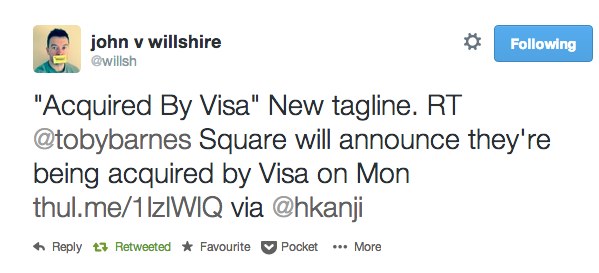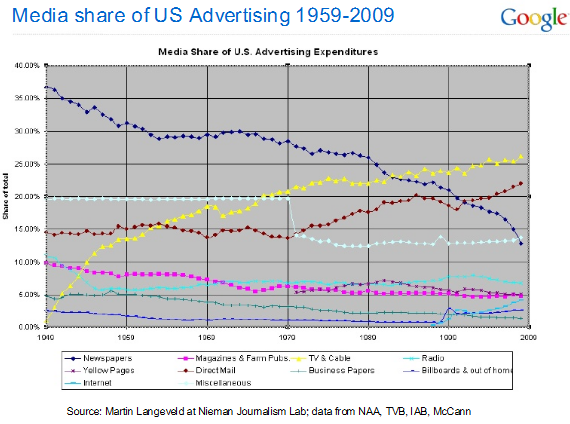So I asked a few people that work in media for their take on the future of news, where is it going, what do they think is going to happen. A very loose question has received some very interesting and insightful answers. Many thanks to: Deirdre O’Shaughnessy, Gareth O’Connor, Laura Slattery, John Kennedy, Adrian Weckler.
Deirdre O’Shaughnessy – Cork Independent
Expensive print is continuing to suffer as online news makes further inroads into peoples’ daily routines. I believe there’s still a place for print; the issue for most outlets is that people are now out of the habit of paying for any content, and that is a major challenge that most news producers still need to get their heads around. As a free newspaper, we are lucky not to be based on a ‘consumer pays’ model, but we are finding that advertisers are still far more willing to pay for print advertising than online advertising. Funnily enough, one of the biggest helps in that regard is going to be Apple – Apple customers are forced pay for music, film, etc. Introducing paywalls to people who already use Apple products will be a lot easier than introducing them to people who use free downloads all the time.
Regarding sourcing of news, I think the realisation has hit most journalists that a person on social media is the new ‘bloke in the pub’. Verification processes should be as stringent when you are told something online by a stranger as if you were told the same thing in a pub by a stranger. Social news isn’t new – it’s only the medium that has changed.
Gareth O’Connor – Storyful
I’ve grown a little tired of the phrase “future of news”, as I like to think more about the present of news. The world of news and journalism is a very exciting place to be right now with a whole host of new tools and technologies which help journalists to do the job faster. In my job at Storyful I live very much in the moment, two to three screens open on my desk at all times. Twitter has become a key tool in my trade, the social platform is where many news stories emerge right now as journalists embrace new storytelling methods. My role at Storyful as Director of News-Gathering involves being the “radar” of our social newsroom, the air traffic control tower if you like. As a social media news agency we pride ourselves on spotting stories quickly and delving into a whole host of social sources to increase understanding and offer context. These methods of news gathering were unheard of ten years ago, before social technologies opened up the web. Often I will have over twenty ‘live’ Twitter lists open on my terminals as we monitor multiple news sources around the world. These methods enable Storyful to react to developing stories really quickly, alerting news clients and activiating our video search discovery team. In a world of real-time news and social streams, this ability to react quickly gives our news team a vital cutting edge.
The key to these new methods of harvesting news is the concept of curation. As the online universe becomes noisy, the role of providing signal in the noise becomes more vital. Trust is a valuable commodity in the world of the social web and increasingly people are looking to experienced journalists to point them towards useful and relevant content. Fine work is being done in this area by news people like Jim Roberts of the New York Times (@nytjim on Twitter) or Neal Mann at the Wall Street Journal (@fieldproducer on Twitter) and our own Editorial Director (@DavidClinchNews) Our entire business model at Storyful is also based on this concept of finding the news from the noise. Every day our team searches the web for the best news content to share with our media partners. Key to all of this is the concept of the open or social newsroom. A big development in the news industry in the coming years will be the notion of the collaborative newsroom where journalists engage with the community on stories of relevance. Some organisations like the Guardian in the UK have already done a lot of work in this area. Legacy media organisations are also starting to embrace the concept of breaking down newsroom walls. The present of news is also about data. A goldmine of data exists for journalists to explore and this will become a more important area in years to come. In some senses the future of news is already here. That’s why I’m so excited about the present.
Laura Slattery – Irish Times
The future of the news business looks a lot like its past: intense, adaptive and alarmingly dependent on the financial commitment of passing moguls. Newspaper groups currently in the game of delivering (or aiming for) hard-news scoops as well as providing colour, context and entertainment may be placed under pressure to pick a side. Even the most genuine scoops very swiftly disseminate into what’s dismissively known as “commodity news”, with every news outlet jumping on the story. Some outlets, therefore, may come under commercial pressure to operate more like premium current affairs magazines ? with much smaller workforces to boot. All in-depth content (not necessarily long-form) will eventually go behind a pay wall as a matter of course, with only entry-level synopses of the events of the day offered for free to news tourists.
News outlets must remember to encourage journalists to stray from the beaten path ? pursuing online traffic by racing to embrace the same stories everyone else is doing will only result in self-defeating feedback loops. The aim should be to deliver content that either ticks some carefully selected ?specialist? boxes, or elegantly communicates a grander story. It?s about having fun without being intellectually flabby, being serious without being dull, and always, always, having some element of novelty. Unfortunately, it is a general rule of thumb that ?better? journalism takes more labour hours to produce: Only news outlets that recognise this and don?t go down a content-farm route will thrive.
Although some of the terms we hear nowadays (curation, aggregation, data journalism) are simply new names for old tricks, this is nevertheless an exciting time to be a journalist. But there will be painful job losses at legacy news organisations and further casualisation in employment. Freelances are finding it harder and harder to make journalism pay – this is worrying if it means that only young people from wealthy backgrounds can ?afford? to pursue it as a career.
John Kennedy – Silicon Republic
(Excuse typos, writing this on my iPhone at 18,000 feet.)
The first thing to understand if you are media is that nothing will wind back the clocks, the ivory towers are collapsing, there are no ‘papers of record’ and the media is truly mass media in the sense that everyone now has a voice and can contribute.
This is something of a rude awakening for traditional media but it is something they need to understand – the audience will crave the raw perspective of a nurse or teacher on the frontline of cutbacks for example as much as they will relish the column and opinion of a distinguished political columnist with impeccable connections. People can tweet, comment, blog, podcast, shoot video and add new dimensions to a story. It is all content and there is no point shouting at the waves ‘go back’ in irritation at the arrival of these other voices and opinions, embrace it.
For news practitioners this is not the end but rather the start of a golden age, but its up to you. Delivering the facts accurately alongside other forms of media like video and audio as well as distributing it socially will mean journalist will have to work even harder and faster than before. Journalists will also need to develop social communities around their brand and approach stories as opportunities to facilitate debate and gather new information.
Traditional journalists will need to be open to new ways of working and collaborating with their colleagues and their audience using social media. This will require a lot more flexibility in terms of working arrangements and will be a challenge for management in newspapers and broadcast outlets to ingrain in their organisation.
News will be fluid and if journalists wish to survive and thrive in this era of change they need to seize and realise the opportunities and adapt. Never before has such a rich array of technology tools and capabilities been at the disposal of journalists – those who embrace them and adapt will survive and prosper.
Adrian Weckler- Sunday Business Post/BusinessPost.ie
News is its own master and will find its own outlet. That’s good news for anyone with a phone and a big challenge for those who have become comfortable with rigid, established routes to an audience (broadcasters, publishers).
According to the latest survey (Ipsos-MRBI), over half of Irish adults have a Facebook account. Half, again, of those adults visit their Facebook page everyday. That is substantially more people than buy a newspaper every day (even if the purpose for visiting can vary). The same survey shows that a fifth of Irish adults have a Twitter account. At the same time, the number of people buying newspapers here continues to fall, at a rate of between five and ten per cent each year.
But newspapers are slowly starting to adapt. It’s becoming rare to find a journalist who doesn’t have — and use — a Twitter account.
I believe that the profitable, commercially sustainable answer to 100,000% more information, stories and opinions floating around networks and platforms is not to water down journalism and research, but the opposite. If you put more research and skill into a story or a feature, it will stand out even brighter, even in an age of aggregation, sharing and retweets. True, you have to pay attention to a framework, business model and all the rest. But there are different models to let you do this, from paywalls to online ads.
The Sunday Business Post has chosen a blended approach (paywall for the Sunday product, free-to-access for The Daily Business Post). Our experience is that people are willing to pay for news they need when it’s packaged to their liking and delivered on the devices they use.
There are some bright, well-executed rivals that have recently come into the Irish market. The Journal and Broadsheet stand out. They are giving the news audience what it has been looking for and no amount of moaning by traditional publishers about the evils of aggregation is going to change this. What established publishers are now starting to do is to take a minute and re-assess their own mojo. When they think long enough about it, they’ll see that The Financial Times makes a lot more money than Gawker, even if it invests a lot more money, too. The barriers to entry for anyone who wants to cover what’s happening around us are now far lower than they were. That means that it’s not enough for a high-paying traditional publisher simply to type up something that occurred or an announcement from a press release: it doesn’t take a degree to do this. Instead, publishers need to do two things: (i) break news and provide superior analysis and (ii) have platforms in place to make sure that the potential reader doesn’t have to strain to get to that news or analysis.






